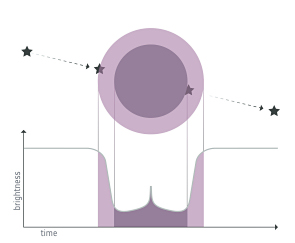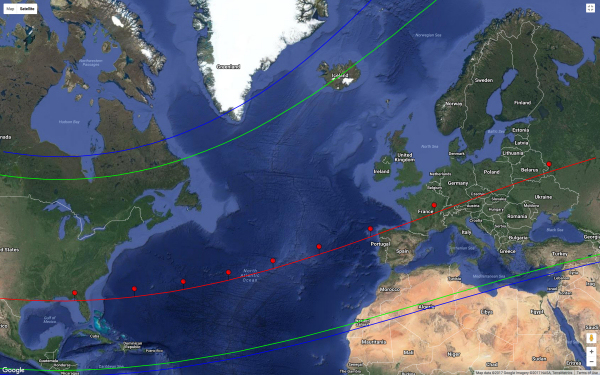Gaia data help prepare for a rare celestial alignment of Neptune's largest moon
3 October 2017
On 5 October 2017, the largest moon of Neptune will pass in front of a distant star. This rare event will temporarily block the star's light from Earth and provide an excellent opportunity to study the moon's intriguing atmosphere. Data from ESA's Gaia mission is allowing astronomers to precisely plan their observations. |
| Image of Triton from Voyager 2. Credit: NASA/JPL |
Alignments of this kind are called occultations. This particular one will be visible from Earth along a track that just skims the southern states of the USA, crosses the Atlantic and then passes through Europe. Observations are planned from Belgium, France, Germany, Greece, Italy, Spain, Switzerland and the UK, by both professional and amateur observers.
Triton is the largest moon of Neptune. In terms of size it is an almost identical twin to Pluto. Also like Pluto, Triton possesses a tenuous nitrogen atmosphere, which the astronomers are keen to study.
 |
| Occultation of a star by Triton. Credit: ESA/ATG medialab |
As the moon drifts in front of the star, some of the starlight passes through the atmosphere and is diverted through a process called refraction. This results in a dimming of the star, from which density, pressure and temperature profiles of the atmosphere can be derived.
To get the best data from the occultation, astronomers have to be on the central track. This is where the alignment between the Earth, Triton and the star is perfect. At this point, astronomers get to see a 'central flash'. This momentary brightening occurs because the atmosphere of Triton acts like a lens that focuses the starlight to Earth. This gives access to the deepest possible atmospheric layers, just a few kilometres above the surface.
However, from the initial prediction of the occultation, the central path's track across the Earth's surface was uncertain by about 1200-1500km. This made it easy to be in the wrong place and miss the flash completely. This is where Gaia came in.
 |
| Ground trace of Triton occultation. Credit: Google, INEGI, ORION-ME; annotation: ERC Lucky Star project |
Data from the publicly available first Gaia release (Gaia DR1) could already give a more accurate ground track but Gaia DR1 only provides this star's position. Knowing its motion on the sky, a quantity called the proper motion, would help to improve the accuracy even more. However, despite Gaia DR1 containing 2 million proper motions, this particular star's motion would only become available in April 2018 with the Gaia second data release (Gaia DR2).
Since the forthcoming Triton occultation presents a rare opportunity to study the atmosphere, Josselin Desmars, an astronomer from the Observatoire de Paris in France, decided to approach the Gaia team and make a special request on behalf of the ERC Lucky Star project. The project, led by Bruno Sicardy from Université Pierre et Marie Curie and Observatoire de Paris, studies the poorly-known, but important, Trans-Neptunian Objects. Desmars coordinates the predictions of this Triton event using recent astrometric measurements of Neptune's moon made in Brazil.
"In April 2017, we asked the Gaia team if we could get some stars from their upcoming second data release in order to refine the prediction and gather observing stations along the central flash," says Desmars. The Gaia team agreed on the importance of the observation and released the preliminary Gaia DR2 position and proper motion to help the campaign [1].
Armed with this information, a much more accurate track has been calculated. Now the various observing stations across Europe can be placed at well-defined offsets to ensure that at least one of them sees the central flash.
The first definitive measurements of Triton's atmosphere were made in 1989 by the Voyager 2 spacecraft during its flyby. It discovered that the atmosphere was extremely tenuous (just one 70 000th of the surface pressure of Earth), extended up to 800 km from the moon's surface, and possessed a temperature of around 38 Kelvin (-235 °C).
Eight years later, an occultation took place that allowed astronomers using the Hubble Space Telescope to measure the atmosphere again. They saw something surprising. Triton's atmospheric temperature had increased by 5%, which could indicate that Triton was warming during the Neptunian summer.
The occultation on 5 October is the first favourable one since 1997 and astronomers want to see if the warming trend has continued.
"We hope to get a lot of observations from professionals and amateurs to let us really study the atmosphere," says Desmars.
This is not the first time Gaia data have been provided for such an event. Desmars also used preliminary Gaia DR2 data for occultations of Chariklo, a distant asteroid. This asteroid is known to have a ring system surrounding it, like a mini Saturn. The Gaia data helped to improve the predicted occultation paths, leading to very successful observational campaigns in the summer of this year.
[1] In May, the Gaia team released the preliminary data for the star that will be occulted by Triton. This week, the Gaia team made public preliminary astrometric data for an additional few hundred stars in the field surrounding Triton to allow astronomers to further improve the occultation predictions. The team cautions that for all of these preliminary data full validation is not yet done and therefore some caution is required when interpreting the results.
Notes for Editors
The star that will be occulted by Triton is UCAC4 410-143659, a 12.7 V-magnitude (12.2 G-magnitude) star, situated in the constellation of Aquarius.
Observations of this occultation by Triton are coordinated by Bruno Sicardy (Université Pierre et Marie Curie and Observatoire de Paris), leader of the ERC Lucky Star project.



